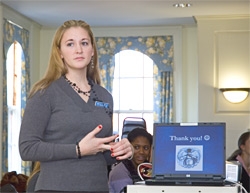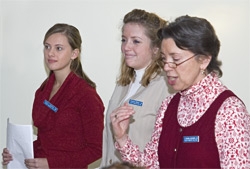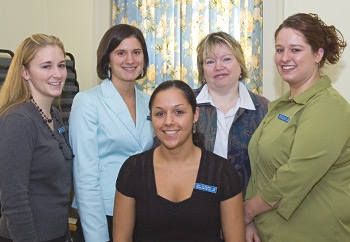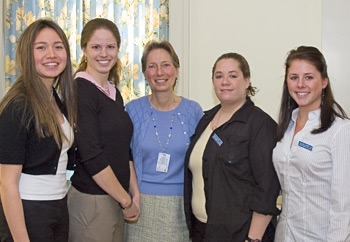Currents: taking New London's pulse
Nursing Capstone Projects Bring Students' Knowledge, Skills Together To Help Communities
While nurses provide acute care to seriously ill patients in hospital settings, it's only part of what nursing professionals do today. As hospital stays grow shorter and less frequent, many nurses are focusing on the larger health concerns of individuals, families and groups in the community.

The Colby-Sawyer Nursing Department has developed a community-based curriculum to prepare student nurses for their changing profession. In their senior year, nursing students put their cumulative knowledge and skills to work in improving the health and well-being of community people and organizations.
For their yearlong Community Capstones, teams of student nurses are working with a visiting nurses program, a diabetes education initiative, and a county-wide effort to assist teen parents and their infants, among other projects. In fall 2006, student nurses began their projects with partnership organizations by conducting community assessments, identifying specific health issues and developing intervention plans.
“Community health nursing requires a broader perspective on nursing,” explains Lea Ayers, associate professor of nursing. “We view the individual as part of a family and the family as part of a community, and we shift our nursing care to address the needs of a population. Nursing interventions at the community level are geared toward health promotion, disease prevention and creating environments that foster the highest level of functioning and quality of life for people.”
In late December, the student nursing teams presented mid-year progress reports to their community partners, fellow students and the Nursing Department's faculty and staff. Four student teams worked with established community partners such as New London Hospital, the Tiger Treatment Program at Newport Middle-High School, the Adult Day Out program in Newport, and the Quail Hollow residential facility for the elderly in West Lebanon.
Two other teams began new community partnerships with the Lake Sunapee Region Visiting Nurses Association and Good Beginnings, a Claremont-based program for babies and young parents in Sullivan County.
Capping Their Student Experience
For their Community Capstones, nursing students draw on their classroom learning, study and clinical experiences and apply them to a larger community context, according to Assistant Professor of Nursing Shari Goldberg.
“In their junior year, the students work with hospitals in clinical settings and with their mentors in patients' homes,” she explained. “Their senior year is the culmination of all their previous work, when student nurses have the opportunity to work in groups and demonstrate leadership and communication skills. The Capstone allows students to develop a sustainable collaborative relationship with community partners to address community health issues.”

The New London Hospital team, including students Paula Spanos, Kate Birdsey, Kochava Duschenes and Greg Perchik, reported on their assessment of New London, the community served by the hospital. The team conducted a community assessment that involved a windshield survey, interviews of community members and hospital staff, and analysis of the community's vital statistics.
“New London has a population of 4,116 people, 30 percent of whom are elderly (65 and above), compared to an average elderly population of 12 percent nationally,” Duschenes explained. “The town has low racial diversity; it's 98.7 percent white, and it's the second wealthiest town in New Hampshire.”
New London Hospital provides primary care and specialized clinical services to the community, Birdsey pointed out. In recent years the hospital has established a long-term extended care center, received designation as a Critical Assess Hospital and became a member of the Dartmouth-Hitchcock Medical Center Alliance.
Identifying a Community Need
The student nurses reviewed health trends among the elderly and found that nationwide, 20.9 percent of all Americans age 60 and above suffer from diabetes. In New Hampshire, diabetes in the seventh leading cause of death. Given New London's large elderly population, the team decided to focus their efforts on a community education campaign about diabetes.
“We determined from our research and interviews that there's an over-abundance of educational materials on diabetes, and that we should streamline this information,” Birdsey added.
Next semester, the team will work with the Physicians Practice Diabetes Quality Improvement Committee, a newly formed group at New London Hospital, to improve the quality and distribution of diabetes education and resources in the community.
Trish Sweezey, the director of nursing practice at New London Hospital, has worked closely with Colby-Sawyer nursing students for the last three years. “The hospital receives a lot of community support, and we're committed to giving back. Our collaborative relationship with the college is a way we can contribute to students' learning,” she said. “Although the students are benefiting from these projects, they're also providing products and services that the hospital can use and which benefit our patients.”
This year's student nurses have brought an abundance of knowledge and enthusiasm to their project. “They're very mature and present themselves professionally. Their community assessment was well done and quite in depth,” Sweezey said, “and they work together very well as a team.”
Building Strong Partnerships
Professor Goldberg has watched the Nursing Department's college-community partnerships mature over the years and blossom into trusting and mutually beneficial relationships.

“What I've noticed with partners like New London Hospital is that they know what our students are capable of, and they've begun to conceive projects with our students in mind,” she explained. “One of our most important goals is balancing the learning needs of our students with the identified needs of the community partners. When you have an organization that's fully invested in what our students are doing and in our goals and objectives, then meaningful and successful experiences are created.”
For many years, Colby-Sawyer student nurses have worked closely with the Lake Sunapee Visiting Nurses Association (VNA), providing services in clinics, accompanying nurse mentors on home care visits and performing family assessments. This year the students are taking the collaboration in a new direction: they have taken the VNA on as a client for one of their Community Capstone projects.
When student nurses Annalese Brown, Adrienne Robbins, Amy Richards and Sarah Taylor conducted their community assessment of the organization, they found it provides a vast array of health and community services in Merrimack and Sullivan Counties. In noting the VNA's strengths, Taylor remarked on the organization's “open and supportive environment, effective communication,” and “emphasis on education.”
Caring for the Caregivers
Yet as the students interviewed VNA administrators and staff and reviewed data about the varying demographics of the organization's clientele, a theme emerged about the health needs of the home health nursing staff themselves. The students learned that the staff work under stressful working conditions and many do not exercise regularly, are overweight and smoke. For their Capstone project, the students will develop and implement a plan to address the health and well-being of the VNA nursing staff.

“We'd like to plan some events for the staff to get them together to socialize, and we hope to plan a health week in which we provide health information and options to them,” says Richards. “We'd also like to organize some fitness classes for the staff and create an informational brochure.”
Kathy Labbe, the VNA's long-term care director, expressed enthusiasm for the students' plans. “They're a great group, and they came up with an excellent idea. Our nursing staff is out in the field, constantly running and traveling from place to place,” she said. “They went into nursing to help others, but they often put their own health on the back burner.”
In Labbe's view, the Nursing Department and the VNA have established a great collaboration which has strengthened both partners. “We gain as much from it as the students do,” she said. “The students' enthusiasm for the profession and their great questions remind us of why we love nursing so much. I also think we're a great place for students to learn about the role of home health nursing, which will be the wave of the future.
“Going forward, as the boomer age, the elderly population will grow in leaps and bounds, and hospitals will not be able to take them. A lot of the care that has historically happened in hospitals, such as IVs and monitoring complex health issues will be done at home by nurses,” she explained.
Reaching All Kinds of Communities
Four other student groups have identified equally important and challenging projects for their Community Capstones. The group working with the Tiger Treatment Program has identified a large population of young students who lack health insurance. They hope to find creative ways to communicate with uninsured and underinsured families and encourage as many students as possible to enroll in the New Hampshire Healthy Kids health insurance plan.
The team working with Good Beginnings will develop a plan to protect the health and safety of nurses who work with these at-risk young families. “Claremont has high crime and substance abuse rates, and with a new infant, these young parents are experiencing some of highest levels of stress in their lives,” Professor Ayers explained. “It's a difficult and sometimes dangerous environment for nurses to come into.”
Other students working with elderly populations will help to develop a more extensive exercise program for an adult day program, while another team will seek to educate residents about the health and wellness options available to them within their facility and in the local community.
As Professor Ayers viewed the student nurses' mid-year presentations, she was amazed by the breadth and scope of the projects.
“In one year, our students are working with prenatal mothers and babies, working people, teens and the elderly. They are working in Grafton, Merrimack and Sullivan Counties,” she said. “Two groups are focused right here in New London, and two of the groups will be focused on the health of the organization's staff and how that impacts the whole organization.”
For this year's senior nursing students, their Community Capstone projects are not just exciting learning opportunities; they are also true opportunities to improve the quality of life for entire communities of people.
-Kimberly Swick Slover


